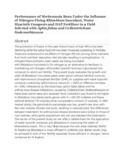Performance of Mwitemania Bean Under the Influence of Nitrogen-Fixing Rhizobium Inoculant, Water Hyacinth Composts and DAP Fertilizer in a Field Infested with Aphis fabae and Colletotrichum lindemuthianum
Date
2021-11-10Author
Naluyange, Victoria
Ochieno, Dennis M. W.
Wandahwa, Philip
Maingi, John M.
Ombori, Omwoyo
Mukaminega, Dative
Amoding, Alice
Odendo, Martins
Muoma, John V. O.
Metadata
Show full item recordAbstract
The production of beans in the Lake Victoria basin of East Africa has been declining while the water hyacinth has been invasively spreading in the lake. These are understood to be effects of nitrogen (N) loss among other nutrients from land and their deposition into the lake resulting in eutrophication. To mitigate these problems, bean seeds are being inoculated with Rhizobium inoculants to fix nitrogen as an alternative to fertilizers in maintaining soil nitrogen; while water hyacinth biomass is processed into composts to enrich soil fertility. The present study evaluates the growth and yield of Rhizobium inoculated seeds when grown without fertilizer (control), with diammonium phosphate fertilizer (DAP), or supplied with water hyacinth composts containing cattle manure culture (H + CMC) or effective microbes (H + EM). Infestations by the black bean aphid Aphis fabae and the anthracnose disease infestations caused by Colletotrichum lindemuthianum on these bean plants were also assessed. Root nodulation was found to be higher in Rhizobium inoculated plants grown with H + EM (20 nodules) and those without fertilizer (19 nodules) when compared to controls (7 nodules). In DAP treated plants, the germination percentage was low, growth rate slow, with few root nodules, flowers and pods, resulting in reduced yield. The differences between treatments for anthracnose disease incidence were similar to those of root nodules; while aphid populations did not vary between the treatments. The results of the present study do not offer a reliable basis for the application of water hyacinth composts and Rhizobium in improving the yields of Mwitemania beans. This is very likely because the soils were relatively fertile; N-fixation by Rhizobium is more efficient in unfertile soils. Better results may be achieved in soils of low fertility especially those deficient in nitrogen, hence conducive for N-fixation.
URI
https://doi.org/10.1007/978-3-030-58065-0_9http://ir-library.mmust.ac.ke:8080/xmlui/handle/123456789/2339
Collections
- Gold Collection [1026]

